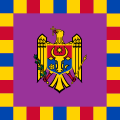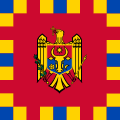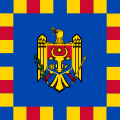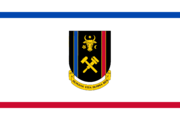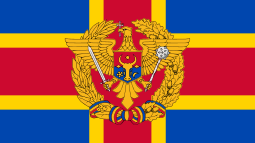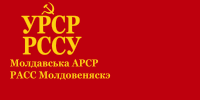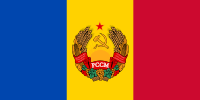
A national flag is a flag that represents and symbolizes a given nation. It is flown by the government of that nation, but can also be flown by its citizens. A national flag is typically designed with specific meanings for its colours and symbols, which may also be used separately from the flag as a symbol of the nation. The design of a national flag is sometimes altered after the occurrence of important historical events. The burning or destruction of a national flag is a greatly symbolic act.

The national flag of Romania is a tricolour. The Constitution of Romania states that "The flag of Romania is tricolour; the colours are arranged vertically in the following order from the flagpole: blue, yellow, red". The flag has a width-length ratio of 2:3; the proportions, shades of colour as well as the flag protocol were established by law in 1994, and extended in 2001. Its similarity to the flag of Chad has caused international discussion.

The State Flag of the Union of Soviet Socialist Republics, or simply the Soviet flag, was a red banner with two communist symbols displayed in the canton: a gold hammer and sickle topped off by a red five-point star bordered in gold. The flag's design and symbolism are derived from several sources, but emerged during the Russian Revolution. It has also come to serve as the standard symbol representing communism as a whole, recognized as such in international circles, even after the dissolution of the Soviet Union in 1991.

The national flag of Ecuador, which consists of horizontal bands of yellow, blue and red, was first adopted by law in 1835 and later on 26 September 1860. The design of the current flag was finalized in 1900 with the addition of the coat of arms in the center of the flag. Before using the yellow, blue and red tricolor, Ecuador's former flag had three light blue stripes and two white stripes with three white stars for each province of the country.The design of the flag is very similar to those of Colombia and Venezuela, which are also former constituent territories of Gran Colombia. All three are based on a proposal by Venezuelan General Francisco de Miranda, which was adopted by Venezuela in 1811 and later Gran Colombia with some modifications. There is a variant of the flag that does not contain the coat of arms that is used by the merchant marine. This flag matches Colombia's in every aspect, but Colombia uses a different design when her merchant marine ships are at sail.
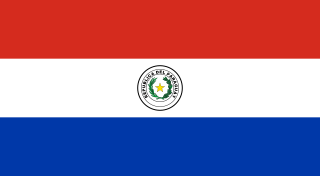
The flag of Paraguay was first adopted in 1842. Its design, a red–white–blue triband, was inspired by the colours of the French Tricolour, believed to signify independence and liberty. The flag is unusual because it differs on its obverse and reverse sides: the obverse of the flag shows the national coat of arms, and the reverse shows the seal of the treasury. It is the only national flag worldwide that has a unique design on each side. The flag consists of the same three horizontal colours as the flag of the Netherlands, which in turn was the inspiration for the French flag. It was revised in 2013 to bring the flag towards its original design. It has a ratio of 11:20.

The flag of the Moldavian Soviet Socialist Republic was adopted on 31 January 1952. The flag has three horizontal bands of red, green (1/4) and red, with a hammer and sickle in the canton. As defined by the Presidium of the Supreme Soviet of the Moldavian Soviet Socialist Republic on the flag description:
The national flag of the Moldavian Soviet Socialist Republic consists of a panel of red color with a green stripe in the middle of the whole flag length, with the image on top of the red part of the flag from the flagpole golden hammer and sickle above a five-pointed red star framed by gold border. The ratio of the flag's width to its length is 1:2 with the bandwidth of green to the width of the flag 1:4

A red star, five-pointed and filled, is a symbol that has often historically been associated with communist ideology, particularly in combination with the hammer and sickle, but is also used as a purely socialist symbol in the 21st century. It has been widely used in flags, state emblems, monuments, ornaments, and logos.
The flags of the Soviet Socialist Republics were all defaced versions of the flag of the Soviet Union, which featured a golden hammer and sickle and a gold-bordered red star on a red field.

In military organizations, the practice of carrying colours, standards, flags, or guidons, both to act as a rallying point for troops and to mark the location of the commander, is thought to have originated in Ancient Egypt some 5,000 years ago. The Roman Empire also made battle standards reading SPQR a part of their vast armies. It was formalized in the armies of Europe in the High Middle Ages, with standards being emblazoned with the commander's coat of arms.

The following is a list of historical military colours, standards and guidons in different countries that do not exist today.
Transnistria is a region in Eastern Europe that is under the effective control of the Russian-backed Pridnestrovian Moldovan Republic but is recognized by the international community as an administrative unit of Moldova, the Administrative-Territorial Units of the Left Bank of the Dniester. The flag of the Prinestrovian Moldovan Republic is a red-green-red triband, while the Administrative-Territorial Units of the Left Bank of the Dniester use the flag of Moldova.
Transnistria is a region in Eastern Europe that is under the effective control of the self-declared Pridnestrovian Moldavian Republic but is recognized by the international community as an administrative unit of Moldova, the Administrative-Territorial Units of the Left Bank of the Dniester.

The flag and coat of arms of Transylvania were granted by Maria Theresa in 1765, when she established a Grand Principality within the Habsburg monarchy. While neither symbol has official status in present-day Romania, the coat of arms is marshalled within the national Romanian arms; it was also for decades a component of the Hungarian arms. In its upper half, it prominently includes the eagle, which may have been one of the oldest regional symbols, or is otherwise a localized version of the Polish eagle. Early versions of the Transylvanian charges were first designed in Habsburg Hungary at some point before 1550, and were therefore symbols of pretence.

The flag and coat of arms of Moldavia, one of the two Danubian Principalities, together with Wallachia, which formed the basis for the Romanian state, were subject to numerous changes throughout their history.

The coat of arms of the Moldavian Soviet Socialist Republic was adopted on 10 February 1941 by the government of the Moldavian Soviet Socialist Republic. The coat of arms is based on the coat of arms of the Soviet Union. It shows symbols of agriculture, an outer rim featuring wheat, corn, grapes and clover. The red banner bears the Soviet Union state motto in both the Romanian language and the Russian language. In Romanian, it was initially "Пролетарь дин тоате цэриле, униць-вэ!"; then, from the 1950s "Пролетарь дин тоате цэриле, уници-вэ!". Both are written in the Latin alphabet as "Proletari din toate țările, uniți-vă!". The acronym MSSR is shown only in Romanian in Moldovan Cyrillic ("РССМ"). The emblem was replaced on 3 November 1990 by the present coat of arms of Moldova. Currently, the unrecognized breakaway state of Transnistria uses a similar state emblem.

This timeline of events is a chronological list of incidents and other notable occurrences related to the War of Transnistria, including events leading up to the war.
The coat of arms of the Moldavian Autonomous Soviet Socialist Republic was the official emblem of the Moldavian Autonomous Soviet Socialist Republic in the Soviet Union, and underwent a number of changes over time.

The colors of the national flag of Romania has a long history, though the association of the three colors only dates to the 18th century. Red, yellow and blue were found on late 16th-century royal grants of Michael the Brave, as well as shields and banners. Thus, the late 13th century Wijnbergen armorial shows the coat of arms of the Wallachian ruler Litovoi as consisting of a shield of ten vertically alternating gold-and-red bands,. The same two colors, gules and or, also appeared on the late 15th century flag and coat of arms of Moldavia, during the reign of Stephen the Great. Then, from the late 16th century until the mid-17th century, the historical coat of arms of Transylvania gradually developed as a shield party per fess, consisting of a black eagle on blue background in the upper field, a dividing red band in the middle, and seven red towers on golden background in the lower field. Finally, in the last quarter of the 18th century, Bukovina gets its own coat of arms from the Habsburg Empire, a blue-and-red shield party per pale with a black aurochs' head in the middle, and three golden six-pointed stars surrounding it. During the Wallachian uprising of 1821, these three colors were present, along others, on the canvas of the revolutionaries' flag and its fringes; for the first time a meaning was attributed to them: "Liberty (blue-sky), Justice, Fraternity ( blood)".

The flag of Riga is one of the official symbols of Riga, along with the coat of arms of Riga. The flag consists of a horizontal bicolour of blue and white, with the coat of arms of Riga in the middle.
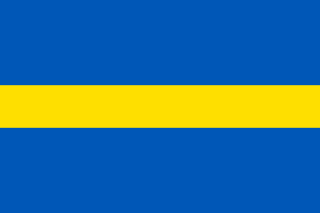
The flag of Cimișlia is the official flag of the city of Cimișlia, in the Cimișlia District, Moldova. It is a simple horizontal tricolor, composed of blue stripes at the top and bottom and a yellow one in the middle. Blue represents the sky and other values and elements, while yellow signifies the richness of Cimișlia's cereals, very important in the history of the city. Previous proposals included the inclusion in the canton (corner) of the coat of arms of the city or a Tatar symbol called danga in Romanian.





